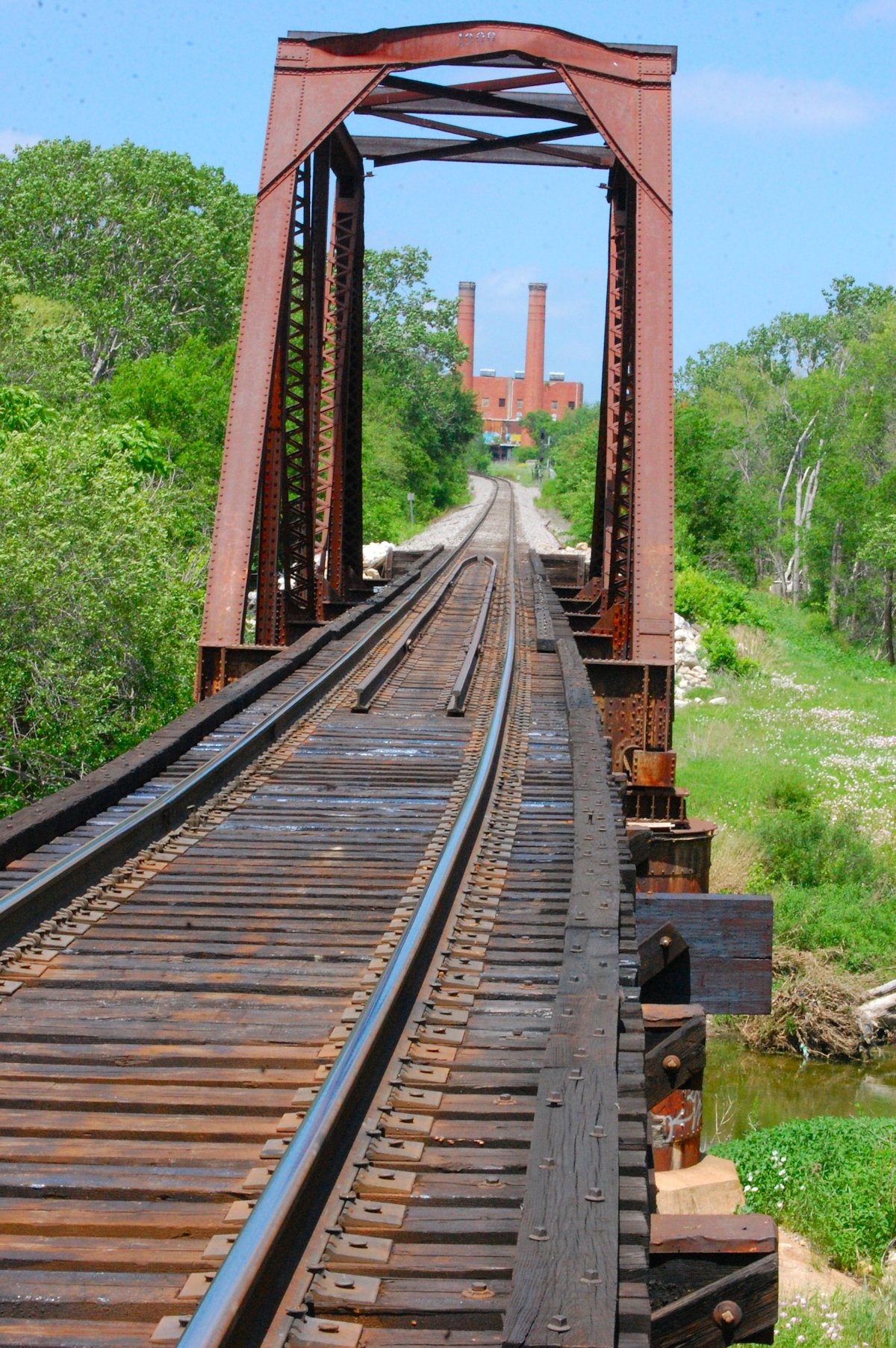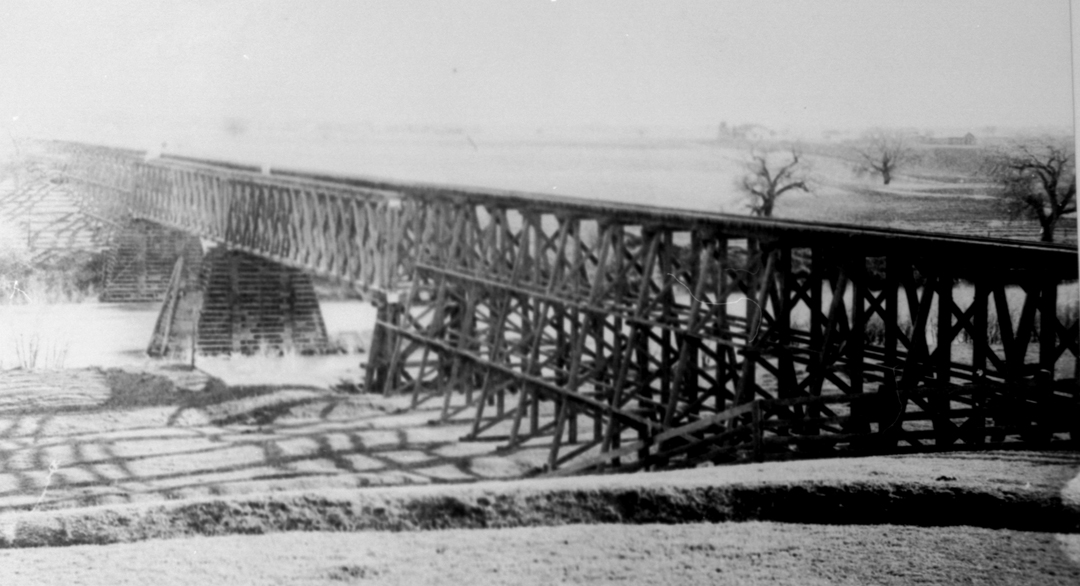I was looking at some bridges for a possible diorama, I was wondering were wood trestles ever used as approaches or supports for steel trusses?
Thanks.
I was looking at some bridges for a possible diorama, I was wondering were wood trestles ever used as approaches or supports for steel trusses?
Thanks.
Yes, they were. Wood trestles are often used for the approach to steel truss bridges. The tendency is to have a stone or concrete abutment actually supporting the truss at its ends, but even then pilings may be used depending on the ground that lies beneath.
Ya mean like this:

Took less than a minute to find that one. Do you young folks know about internet searching? It’s, how do you guys say, COOL!.
That shot looks a lot like it’s the trestle/bridge system paralleling US 80 just west of Sacramento. But that would be wrong: Tempe Lake Bridge on the SP.
Brazos River:
![]()
I put this one in because I can see the tie-in for a sway brace on the lower right.

These are all low trestles. I think it unlikely you’ll find a steel truss span used in a high trestle.
Ed
And the bent cross beam at the top. You’d think that would’ve done some damage to whatever hit it. Funny the other end isn’t bent.
Mike.
Wow! Yes.
Note, also, what is entirely missing at that same location at the other end.
Good time, good times!
Ed
Here’s another example of a combination through girder, twin modified Pratt Trusses, another through girder, and what’s left of a timber trestle. This is over the Gaspereau River in Nova Scotia, part of the abandoned Dominion Atlantic Rwy.
An interesting round-over on the end of the girder. Since there’s not one at the other end, I’m gonna assume it was done to keep low hanging loads from slamming the end of the girder. Which I’ve never seen before. But it also might explain the more common double-ended version of the round-over.
I would have thought they’d use a deck girder. Is there a road underneath that needs the clearance?
By the way:
In the above photo, there is one bridge but a least four spans (depending on how you classify the trestle)(two truss and two girder). Abutments are normally only at the ends of a bridge–besides vertical support, they hold the embankment back and provide longitudinal stability. Piers are used between abutments. And trestles, again, kind of cloud the issue.
Ed
Yeah I was hoping that there would be some high trestle examples, I might do something like Stanislaus River Bridge that was in MR a while back.
This an interesting read, with photos.
http://www.tidewatersouthernrailway.org/index.php/bridges/stanislaus-river
Mike.
Ed, I get the suspicion that this river crossing has seen at least two different versions of construction in the 100 years that it has been present. It could be that the girder closest to us was modified to fit that odd pier-that-looks-like-an-abutment, and slid from the span now occupied by the Pratt. This entire area is frequently tidally flooded…Bay of Fundy with its extraordinary tides. Maybe they came close to loosing the first construction and modified it by lengthening it to span to higher ground? That is to say, it’s kinda untidy, if interesting and appealing in its own right, so it is probably tinkered with.
As I suggested above, I think this bridge is different from a previously existing, perhaps original, perhaps not, version. There most definitely would NOT have been a road anywhere near the bridge. Tidal plain. The Gaspereau (GAS-pero) river runs in a deep tidal mud-flat type channel, great for paddle boarding, tubing, and kayaking. The main highway runs NE/SW at this point, about 400 yards to the east of the bridge, and we had to park at a farmer’s field and walk about 400 yards to get to the bridge acr
And it’s a great example of a bridge on a curve.
Ed
google black warrior river bridge
Three story high trestle. Taller than the others.
And another interesting bridge.
Ed
Ok how does a wood approach trestle, a steel deck truss, a through truss over the navigable channel, another deck truss and lastly the second approach trestle.
I really like the stacked timber piers that the Stanislaus had, maybe I can use stone but use the timbers as the break water (not sure if I have the right term).
Anyone know of a good steel deck truss kit, I know Central Valley makes really nice through trusses and Walthers has the Cornerstone deck truss but I don’t think the Walthers model would look very good with the higher detailed CV kit.
I could be wrong though!
I used the Central Valley through girder with Walthers wood pile bents and I like the results:
It is an industrial area, wood was cheap but steel had to be used to span four tracks below.
The Walthers Pratt truss wouldn’t work?
Exactrail makes a beautiful 72 foot deck girder. Sadly, it is not a kit nor a truss so does not meet your criteria.
https://exactrail.com/collections/all/products/72-deck-plate-girder-bridge-wood-handrails-gn
There are several lengths, handrail options and paint jobs available.
Good Luck, Ed
I’d replace the deck trusses with deck girder.
There’s a reason for the choices designers make in doing bridges. For example, trusses will make longer spans, but cost more. So when you NEED a longer span, you use a truss. If you don’t, the girder would be the choice. So, in your idea, above, there would have to be a reason to choose deck truss over deck girder. Regarding the trestle: I expect most of the time, they would use fill instead of the trestle. But when you use a trestle, it will allow water flow. Fill won’t. That is why there is still a long trestle on the line just west of Sacramento. The river overflows on occasion–through the trestlework.
I’m not finding anything close to what you’ra talking about when you use the term “Stanislaus”. How about a link to a photo. Or two.
Masonry is a bad choice for bridge supports. You are HOPING the mortar holds. Or you are using huge stones that are beautifully fitted. Very expensive. Concrete is the preferred choice.
Wood pilings around the concrete can be used to protect it from impacts delivered via the water.
Ed
I’m looking through the archives, not finding anything. Maybe we’re all talking about different bridges over the Stanislaus river.
After a search, I see there were others.
Mike.
This is the bridge I’m talking about.




Those are the best pictures I could find.
Nice-looking bridge, Steven, but it would be nice, I think, to give credit to the builder and/or the photographer.
Wayne
My compliments to the soon-to-be identified bridge builder. Beauty, as they say in a country far, far away.
Steven,
That is an excellent recreation of an old wooden bridge. Notice how lightly built it is.
From the way the two piers are framed, it looks like they were designed to hold in loose rock. When the model is done, you should see lotsa little HO pebbles inside. Should look way-kool!
Upstream (to the left), that would be a structure to protect the center pier from ice damage.
I am not sure if the river is navigable. I note that the spans are deck, not through; so I lean towards no.
You would never see those wood trusses replaced by steel unless the entire bridge was also modified. The trestle looks to be on a flood plain. Therefore I think they would have replaced the wood trestle with a steel one (see Microengineering). I do note that one example, above, has a similar wood trestle approach to the main spans. So a (much sturdier) wood trestle is not impossible, though I think it unlikely. It looks to me that the real one has the trestle resting directly on the ground-adequate for a very temporary installation. Not for anything longer. I can’t tell if the model is built with foundations for the bents, or if that is supposed to be ground, with plaster filling in later. A non-temporary trestle would have either a driven pile foundation or a concrete one. That is because the overflow of the river will tend to erode the ground around the trestle.
The two piers would have been replaced by concrete, either completely, or with a concrete foundation supporting a steel pier.
The truss spans might have stayed as deck style, especially if the river stayed non-navigable. Deck trusses are cheaper than through.
That beautiful wood bridge looks to me to have been a very temporary job, just to get the railroad thr